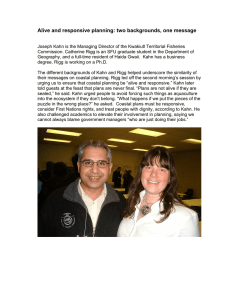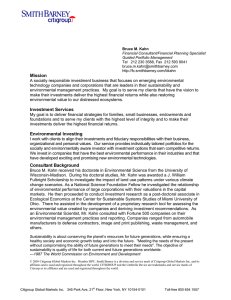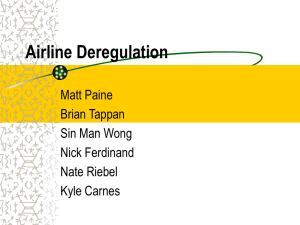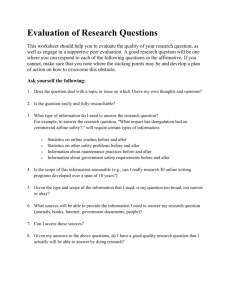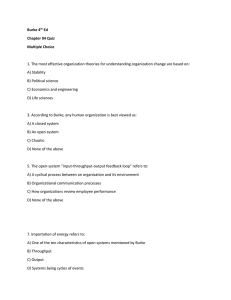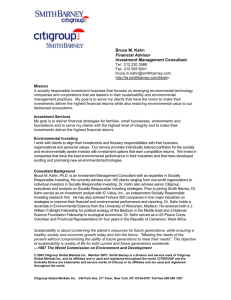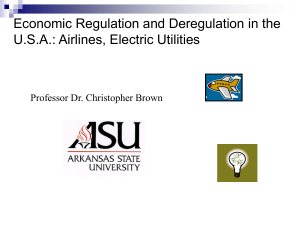After Airline Deregulation and Alfred E. Kahn Please share
advertisement
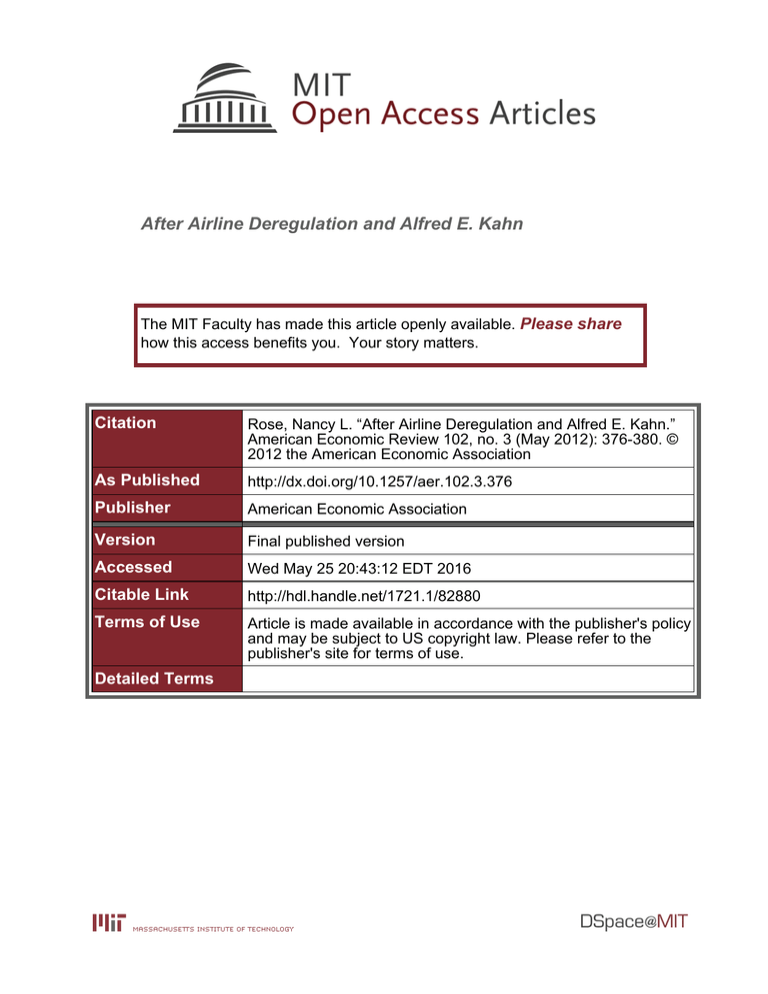
After Airline Deregulation and Alfred E. Kahn The MIT Faculty has made this article openly available. Please share how this access benefits you. Your story matters. Citation Rose, Nancy L. “After Airline Deregulation and Alfred E. Kahn.” American Economic Review 102, no. 3 (May 2012): 376-380. © 2012 the American Economic Association As Published http://dx.doi.org/10.1257/aer.102.3.376 Publisher American Economic Association Version Final published version Accessed Wed May 25 20:43:12 EDT 2016 Citable Link http://hdl.handle.net/1721.1/82880 Terms of Use Article is made available in accordance with the publisher's policy and may be subject to US copyright law. Please refer to the publisher's site for terms of use. Detailed Terms American Economic Review: Papers & Proceedings 2012, 102(3): 376–380 http://dx.doi.org/10.1257/aer.102.3.376 In Remembrance of Alfred E. Kahn: Fred Kahn’s Impact on Deregulation and Regulatory Reform ‡ After Airline Deregulation and Alfred E. Kahn† By Nancy L. Rose* ­productivity (e.g., Borenstein and Rose 2008). And its compelling demonstration of the ben­ efits of replacing regulation with competition advanced a broader reform agenda, both in the United States and abroad. “Without airline deregula­tion, … we probably would not have been able … to deregulate trucking, railroads, and buses, or continue along the same path with other major industries” (Kahn 1988a, p. 22). The history and politics of airline deregula­ tion and eco­ nomic assessment of its impact have been exhaustively analyzed and summa­ rized.1 This paper instead highlights a handful of lessons that Kahn and the deregulated airline industry impart for students and practitioners of economic regulation—lessons that apply well beyond airlines. Given the perceived failures of “deregulation” in the post-2008 financial crisis world, some may prove especially timely. I begin by baldly stating my essential conviction: airline deregulation has been a nearly unqualified success, despite the industry’s unusual vulner­ability to recessions, acts of terrorism, and war. —Kahn, 2004 Alfred E. “Fred” Kahn is widely remem­ bered as “The Father of Airline Dereg­ulation.” Though he consistently redistributed credit for the reform (e.g., Kahn 2008), Kahn’s candor, wit, and willingness as chairman of the Civil Aeronautics Board (CAB) to step outside the “regulation as usual” box established him as the face at its forefront. This legacy is enormous, as the 1978 Airline Deregulation Act may be one of the greatest microeconomic policy accom­ plishments of the past fifty years (Bailey 2010). The policy is notable for several reasons. It was the first dismantling of a substantial eco­ nomic regu­latory apparatus, and one of the only instances that included abolition of the relevant regula­ tory agency. Deregulation dramatically transformed the air­ line industry. The postde­ regulation US air­line industry generated lower average fares; greater numbers of flights, non­ stop destinations, and passengers; ­dramatically different network structures; and increased I. Regulating Well is Hard The Economics of Regulation: Principles and Institutions (Kahn 1970, 1971) remains a masterful and relevant assess­ment of the theory and practice of economic regulation. Airline regulation garnered a rela­tively brief discussion in this work, perhaps contributing to Kahn’s initial rejection of the CAB role, arguing he should switch places with “whoever might be named to the chairmanship of the Federal Communications Commission … [as he] can’t possibly know less than I about the airline industry” (Kahn 2008, p. 619). Notwith­standing that disavowal, Kahn’s command of regula­tory ‡ Discussants: Sam Peltzman, University of Chicago; Roger Noll, Stanford University. * Rose: MIT Department of Economics, 50 Memorial Drive, E52-280B, Cambridge, MA 02142 (e-mail: nrose@ mit.edu). I thank MIT and the National Bureau of Economic Research for support and James Poterba for his comments. This paper owes much to 30 years of discussing regulation with Paul Joskow, 25 years of collaborating with and learn­ ing from Severin Borenstein on airlines, and, of course, Fred Kahn’s inspiring work and examples. † To view additional materials, visit the article page at http://dx.doi.org/10.1257/aer.102.3.376. 1 With apologies to the many authors thus referenced only indirectly, the papers cited in Borenstein and Rose (2008) may provide interested readers with an entry point to this literature. 376 VOL. 102 NO. 3 after airline deregulation and alfred e. kahn p­ rinciples and challenges gave him confidence, after a brief immersion in the role as CAB chair­ man, to push the agency toward deregulation. Insights from that work and experience remain fresh, and include: A. Regulation Is Information-Intensive Economic regulation frequently substi­ tutes regulators’ judgment for firm decision making and impedes the ability of markets to provide feedback on that judgment. But even wellinformed regulators typically know much less than firms do about efficient choices. Theoretical models highlight the complexity asymmetric information introduces to regulatory price deter­ mination (e.g., Laffont and Tirole 1993), but prices may be far from the most complex deci­ sions regu­lators face. For example, CAB entry awards at the route level de facto determined airline network structure. Kahn recalled saying If I knew what was the most efficient configuration of routes in the airline system, then I could continue to regulate. But since I can’t tell you whether it’s going to be a Delta kind of operation or … more like the Eastern shuttle or South­ west Airlines it doesn’t make sense to leave it to an ignorant person like me to tell airlines how they can best configure their routes (Public Broadcasting Sys­tem PBS 2000). B. Incentives Matter Firms respond to regulatory incentives, even when regulators may not clearly understand the incentives they have created. The CAB in the 1960s and 1970s was caught in a spiral of increasing fares to chase ever-lower load fac­ tors, in largely fruitless pursuit of higher rates of return for the industry. With regulated prices fixed sub­stantially above marginal costs, car­ riers could increase profits by competing for more passengers through nonprice dimensions that ranged from larger, faster aircraft and more frequent flights to designer flight attendant uni­ forms and piano bars. And so they competed. As Kahn trenchantly noted If price is prevented from falling to marginal cost in the short run or to average total cost in the long run, then, to the extent that competition prevails, it will tend to raise cost to the level of price. Only 377 when, in this way, marginal cost is once again equated with price will the tendency to service inflation be halted (Kahn 1971, p. 209). After deregulation allowed price competition, average fares declined, load factors increased, and many in-flight amenities began to disap­ pear (Borenstein and Rose 2008). Despite com­ plaints about crowded flights and poor service quality, particularly from business travelers, the competitive market has “proved to the satisfac­ tion of the carriers that most travelers are will­ ing to sacrifice comfort for lower fares” (Kahn 2004, p. 3–4), and airlines have responded accordingly. C. Ignore Institutions at Your Peril Kahn’s division of The Economics of Reg­ ulation into a first volume based on the “Principles,” or theory, of regulation, and a second focused on its “Institutions” attests to the central role he assigned to institutional fac­ tors. These may, for example, explain why two “structurally competitive” industries subject to apparently similar regulation experience dra­ matically divergent outcomes—as under federal price and entry regulation of the trucking and airline indus­tries. The higher profit rates earned by regulated trucking firms may be attributed, at least in part, to their ability to use rate bureaus to facilitate collusion, some­thing the CAB effec­ tively blocked in the airline industry. Failing to appreciate the significance or implications of institutions may undermine both the credibility of economic research and the contributions of regulatory policy. D. Innovation Increases the Challenges As firms respond to incentives and regula­ tory ignorance, regulators often find them­ selves in something like the arcade game of “Whac-A-Mole.” Firms “relax” regulatory con­ straints through behaviors that regulators fail to anticipate, increasing profits by actions not covered by existing rules. Vigilant regulators, responding to these actions, revise constraints, and firms start the effort to bypass regulations anew. The regulatory rule is: each time the dike springs a leak, plug it with one of your 378 MAY 2012 AEA PAPERS AND PROCEEDINGS fin­ gers; just as dynamic industry will perpetu­ ally find ways of opening new holes in the dike, so an ingenious regulator will never run out of fingers (Kahn 1979, p. 11). far too often neglected in discussions that pre­ sume one simply needs “better regulation” or “better-intentioned” regulators to correct a given market failure. II. Markets Are Messy In an industry with potentially rapid inno­vations to processes or products, these challenges are magnified, as are the costs of regulatory errors. Less vigilant regulators end up with outmoded regula­ tion at best, and potentially disastrous conse­quences at worst. Failing to regulate com­ petition through ever larger in-flight sandwich sizes may merit a Colbert Report–style comedy sketch; capital risk regulation that fails to detect and control off-balance sheet derivatives is no laughing matter. Failing to adapt regulation to industry changes, rather than “deregulation” per se, seems a more plausible explanation for many of the regulatory failures leading to the 1980s Savings and Loan debacle (PBS 2000) or the 2008 financial crisis. E. Regulation May Be More Costly than the Market Flaws It Is Designed to Correct Introductory microeconomics courses describe myriad market-failure rationales for government intervention to restore competitive ideals. Given the many challenges confronting regulators, it should come as no surprise that the empirical and theoretical regulatory economics literatures of the past half-century overwhelm­ ingly con­clude that such interventions are nei­ ther costless nor perfect. As Kahn emphasized (1971, p. xii) When we turn from the normative question of what we want to the institutional ques­ tion of how we get it, we find ourselves launched into the baffling arena of social and political as well as economic behavior and organizations, into the real world of ignorance, error and corruption, where all institutions are in varying degrees imper­fect. The policy trade-off is not between imper­ fect markets and perfect regulation, but choos­ ing which flaws—market or regulatory—are less costly. In many cases, the imperfectly ­competitive market is far superior to inherently imperfect regulation. This conclusion, while familiar to students of economic regulation, is The airline industry’s considerable and per­ sistent turmoil over the nearly 35 years since deregulation has been surprising and troubling. Much has been made of low and volatile aggre­ gate profits and high rates of firm turnover and bankruptcies, particularly by those calling for a return to regulation. And while average fares have fallen, the variance of fares has exploded (Borenstein and Rose 2008). Does this argue for more ordered regulated markets? Earnings vol­ atility is not confined to the deregulated era, although aggregate losses are more prevalent during this period (Borenstein and Rose 2008, and Borenstein 2011a). Adverse demand and fuel price shocks undoubtedly are part of the story, and unrelated to deregulation. The nature of airline labor negotiations, with contracts that typically fix wages for the future based on past profitability, also may exacer­ bate profitability swings (Borenstein and Rose 2008). If firms respond strategi­cally to union bargaining by increasing their financial leverage (Matsa 2010), this may further increase earnings volatility and perhaps bankruptcy rates. But Borenstein (2011a) suggests that per­ sistently higher costs of legacy airlines relative to low-cost carriers (LCC) that have expanded since deregu­ lation, and the declining ability of legacy car­riers to realize price premia over LCC fares, also may play important roles. Over the past 20 years, competition from LCCs has increased dramatically. More than 60 percent of US passengers in 2010 traveled on routes with LCC presence, and the aggregate LCC share of passenger miles has tripled since 1990, to roughly 30 percent (Borenstein 2011b). While painful for legacy airlines and their employ­ ees, this is “competition doing exactly what we hoped and expected it to do” (Kahn 2008b, p. 316–17). LCC expansion also appears coin­ cident with some reduction in fare dispersion (Borenstein and Rose 2008; Borenstein 2011b), though dispersion is very unlikely to disappear in an industry managing fixed capacity with sto­ chastic demand and heterogeneous customers. VOL. 102 NO. 3 after airline deregulation and alfred e. kahn Financial volatility has not thus far impaired the industry’s ability to finance investment, sug­ gesting that claims of “destructive competition” are likely mis­ placed. Competitive dynamics may appear disorderly, but as Kahn (2004, p. 5) argues, even “… the unusual vulnerability of an industry to external shocks does not consti­ tute a legitimate case for a return to regulated cartelization.” III. Deregulation Does Not Mean “Laissez-Faire” Two of the unfortunate “surprises” Kahn noted in his 1988 retrospective were not inevi­ table consequences of deregulation: increased concentration of market power, particularly in hub markets, and escalating costs of airline delays and airport congestion. These owe their origin more to failure of ancillary government policies than to airline deregulation per se. The early years of deregulation saw enor­ mous entry into airline markets: existing carri­ ers expanded into new markets and new carriers entered the industry. But the 47 new carriers that had entered the industry by 1984 were quickly eclipsed by the exit of 48 carriers by liquidation or acquisition over the next 3 years. During the subsequent decade, industry concentration rose, particularly on hub routes, prompting concerns about the exercise of market power and stability of the early deregulation price declines. Kahn (1988b, p. 318) argued this in large part reflected a “lamentable failure of the admin­ istration to enforce the policies of the antitrust laws—to disallow a single merger or to press for divestiture of the computerized reservation systems or attack a single case of predation.” Encouragingly, Borenstein (2011b) finds some evidence that market power may have moderated in recent years, particularly at the most domi­ nated hub airports and for the highest-end fares. Crowded flights and airports and flight delays have frustrated travelers and policymakers. Delays were particularly exasperating to Kahn, who had long advocated congestion pricing in regulated monopoly settings, and argued for this explicitly in his days at the CAB. He later laid the blame squarely on the “major derelictions” of the relevant government and airport a­ uthorities, who “on the one hand failed ­efficiently to expand airport and air traffic control capacity and, on the other, to price those scarce facilities at their 379 marginal opportunity costs. No wonder there are shortages” (Kahn 1988b, p. 321). The political failure to adopt sensible policies toward air­port investment and congestion pric­ ing has been accompanied by an inability of the Fed­eral Aviation Administration to effectively modernize the technology infrastructure used by the air traffic control system. These all impede the efficient operation of the air transportation network and reduce the social surplus associ­ ated with air travel. They should be addressed through improved infrastructure policy, not shrinking the industry through reregulation. Researchers and policymakers would do well to heed these lessons from Kahn, a man who taught us that facts make a difference, if only we have the humane procedures to un­cover them and the brains to understand them; and that intellectual rigor, decked out in wit and flair, even in Washington, can be a winning combination (Shenefield 2003, p.1). We shall sorely miss that combination. REFERENCES Bailey, Elizabeth E. 2010. “Air-Transportation Deregulation.” In Better Living Through Economics, edited by John J. Siegfried, 188–202. Cambridge, MA: Harvard University Press. Borenstein, Severin. 2011a. “Why Can’t US Air­ lines Make Money?” American Economic Review 101 (3): 233–37. Borenstein, Severin. 2011b. “What Happened to Airline Market Power?” Unpublished. Borenstein, Severin, and Nancy L. Rose. 2008. “How Airline Markets Work … Or Do They? Regulatory Reform in the Airline Industry.” National Bureau of Economic Research Work­ ing Paper 13452. Kahn, Alfred E. 1970, 1971. The Economics of Regulation: Principles and Institutions. Vol. 1 and 2. New York: John Wiley & Sons. Kahn, Alfred E. 1979. “Applications of Econom­ ics to an Imperfect World.” American Economic Review 69 (2): 1–13. Kahn, Alfred E. 1988a. “I Would Do It Again.” Regulation 22 (2): 22–28. 380 AEA PAPERS AND PROCEEDINGS Kahn, Alfred E. 1988b. “Surprises of Airline Deregulation.” American Economic Review 78 (2): 316–22. Kahn, Alfred E. 2004. Lessons from Deregulation: Telecommunications and Airlines after the Crunch. Washington, DC: Brookings Insti­ tution Press. Kahn, Alfred E. 2008. “Reflections of an Unwit­ ting ‘Political Entrepreneur.’ ” Review of Network Economics 7 (4): 616–29. Laffont, Jean-Jacques, and Jean Tirole. 1993. A Theory of Incentives in Procurement and Regulation. Cambridge, MA: MIT Press. MAY 2012 Matsa, David. 2010. “Capital Structure as a Strate­ gic Variable: Evidence from Collective Bargain­ ing.” Journal of Finance 65 (3): 1197–1232. Public Broadcasting System (PBS). 2000. “Inter­ view with A. E. Kahn.” First Measured Cen­ tury: A Look at American History by the Numbers. Ben Wattenberg, host. http://www. pbs.org/fmc/interviews/kahn.htm (accessed 1/1/2012). Shenefield, John H. 2003. “Remarks in Tribute to Alfred E. Kahn on the Occasion of P ­ resentation of the American Antitrust Institute Antitrust Achievement Award.” June 23.
